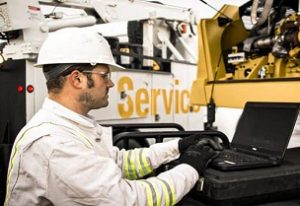
DRIVE TRAIN PARTS
 Drive train components must endure incredible torque, high impact loads, and frequent direction and gear changes. Cat designs and manufactures its transmissions and final drive components with these demands in mind, using testing processes that simulate real-world applications. The result is a drive train that lasts longer and works harder over the life of your machine. Learn more about drive train components below.
Drive train components must endure incredible torque, high impact loads, and frequent direction and gear changes. Cat designs and manufactures its transmissions and final drive components with these demands in mind, using testing processes that simulate real-world applications. The result is a drive train that lasts longer and works harder over the life of your machine. Learn more about drive train components below.
TRANSMISSION
The power coming from the engine must be turned into useful power by controlling its speed, direction, and force. Transmissions do this using either hydraulically engaged planetary clutches or hydrostatic/hydraulic drives. Each of these methods provides different characteristics of ground speed, torque, clutches maneuverability, and implement force.
Because of the wide variety of work they do, Caterpillar products use several types of transmissions, each designed to convert engine power into the exact combination of speed and force required by individual machines.
TORQUE CONVERTER
The power that is produced in the engine is multiplied in the torque converter and then transferred on to the transmission for use by the rest of the drive train components. Some Cat machines use a torque divider instead of the traditional torque converter, which divides the transmitted torque between the front and rear axles, with the rear receiving the majority. The three basic torque converter components include the impeller, the turbine, and the stator.
DRIVE SHAFT
The driveshaft is a means of connecting drive train components. It allows for misalignment in the drive. The output shaft connects to the transmission through a yoke and driveshaft or directly to the transmission input gear.
Caterpillar’s exact design for proper measurements and precise machining ensures proper gear alignment. Special heat treatment achieves proper surface hardness, core hardness, and hardened depth.
DIFFERENTIAL
The differential decreases the speed and increases the torque as needed for each wheel’s motion adjustment. When a machine is turning, the differential supplies the needed adjustments to the wheels, allowing the outside wheel to move at a faster pace than the inside wheel.
The components of the differential are the differential case assembly, the pinion gears, the side gears, and the spider. The differential’s key functions are:
- Transferring power coming from the transmission to the left and right axle shafts
- Balancing the power according to the demand of each wheel
- Further reducing the speed and increasing the torque to drive the rear wheels
